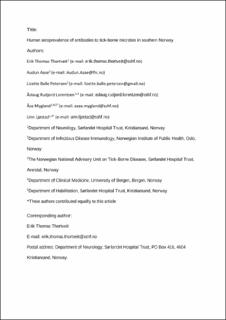| dc.contributor.author | Thortveit, Erik Thomas | |
| dc.contributor.author | Aase, Audun | |
| dc.contributor.author | Petersen, Lizette Balle | |
| dc.contributor.author | Lorentzen, Åslaug Rudjord | |
| dc.contributor.author | Mygland, Åse | |
| dc.contributor.author | Ljøstad, Unn | |
| dc.date.accessioned | 2021-07-02T11:04:40Z | |
| dc.date.available | 2021-07-02T11:04:40Z | |
| dc.date.created | 2020-06-26T11:45:24Z | |
| dc.date.issued | 2020 | |
| dc.identifier.issn | 1877-959X | |
| dc.identifier.uri | https://hdl.handle.net/11250/2763100 | |
| dc.description.abstract | The tick Ixodes ricinus is widespread along the coastline of southern Norway, but data on human exposure to tick-borne microbes are scarce. We aimed to assess the seroprevalence of IgG antibodies to various tick-borne microbes in the general adult population living in a Norwegian municipality where ticks are abundant. Søgne is a coastline municipality in the southernmost part of Norway, and has a high density of ticks. All individuals aged 18-69 years with residential address in Søgne municipality (n = 7424) were invited to give a blood sample and answer a questionnaire. Blood samples from 3568 individuals were available for analysis. All samples were analyzed for IgG antibodies to Borrelia burgdorferi sensu lato (Bbsl), and around 1500 samples for IgG antibodies to other tick-borne microbes. Serum IgG antibodies to Bbsl were present in 22.0% (785/3568) of the tested samples, tick-borne encephalitis virus (TBEV) in 3.1% (45/1453), Anaplasma phagocytophilum in 11.0% (159/1452), Babesia microti in 2.1% (33/1537), Bartonella henselae/B. quintana in 0.1% (2/1451) and Rickettsia helvetica/R. conorii in 4.2% (60/1445). Serum IgG antibodies to A. phagocytophilum and R. helvetica/R. conorii were significantly more prevalent (p = 0.010 and p = 0.016, respectively) among individuals with serum IgG antibodies to Bbsl than among individuals without. In conclusion, our study showed a high exposure to Bbsl in the general adult population living in a coastline municipality in the southernmost part of Norway. The population is also exposed to A. phagocytophilum, R. helvetica/R. conorii, B. microti and TBEV, but very rarely B. henselae/B. quintana. | en_US |
| dc.language.iso | eng | en_US |
| dc.publisher | Elsevier | en_US |
| dc.rights | Attribution-NonCommercial-NoDerivatives 4.0 Internasjonal | * |
| dc.rights.uri | http://creativecommons.org/licenses/by-nc-nd/4.0/deed.no | * |
| dc.title | Human seroprevalence of antibodies to tick-borne microbes in southern Norway | en_US |
| dc.type | Journal article | en_US |
| dc.type | Peer reviewed | en_US |
| dc.description.version | acceptedVersion | en_US |
| dc.rights.holder | Copyright 2020 Elsevier | en_US |
| dc.source.articlenumber | 101410 | en_US |
| cristin.ispublished | true | |
| cristin.fulltext | postprint | |
| cristin.qualitycode | 1 | |
| dc.identifier.doi | 10.1016/j.ttbdis.2020.101410 | |
| dc.identifier.cristin | 1817268 | |
| dc.source.journal | Ticks and Tick-borne Diseases | en_US |
| dc.source.40 | 11 | |
| dc.source.14 | 4 | |
| dc.identifier.citation | Ticks and Tick-borne Diseases. 2020, 11(4), 101410 | en_US |
| dc.source.volume | 11 | en_US |
| dc.source.issue | 4 | en_US |

